|
|
|
Sort Order |
|
|
|
Items / Page
|
|
|
|
|
|
|
| Srl | Item |
| 1 |
ID:
175707


|
|
|
|
|
| Summary/Abstract |
As a speech act, takfir—the allegation of a Muslim’s apostasy—may insinuate violence in a way that can delimit the boundaries of political, as well as religious, community. Yet the use of takfir also incurs costs in plural political environments. Those who engage in it do not always see the dividends they may imagine. This article compares public acts of takfir at critical moments in Tunisia and Yemen to argue that the weight of this particular idiom is not universal, but is a function of the specific linguistic field in which it is employed as well as the historical juncture in which it takes place. Takfir both shapes and reflects the power relations between rival factions. As an informal discourse that occurs largely outside of formal state institutions, it nonetheless leaves a clear imprint on those institutions, particularly in moments of political transition when the contours of new constitutional arrangements are negotiated. Relying on ethnographic and interview-based field research from both Tunisia and Yemen, the context-specific arguments advanced here challenge the universalist prescriptions that underwrite policy efforts to engage in “counter-takfir” as a means of combatting excommunicative discourse.
|
|
|
|
|
|
|
|
|
|
|
|
|
|
|
|
| 2 |
ID:
129908
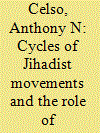

|
|
|
|
|
| Publication |
2014.
|
| Summary/Abstract |
The article argues that Islamist terror is driven by irrational forces; it analyzes jihadist values and doctrines that animate Islamic revolutionaries; it then contends that jihadist movements go through a cycle of mobilization, extremism, implosion and recreation. Finally, it assesses the prospects for jihadist revitalization, extremism, and decline in Syria and the Sahel. Examples from the Iraqi and Algerian jihadist campaigns are used for illustrative purposes throughout.
|
|
|
|
|
|
|
|
|
|
|
|
|
|
|
|
| 3 |
ID:
174379
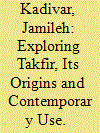

|
|
|
|
|
| Summary/Abstract |
Muslims have been the primary targets of Daesh’s attacks since 2014 in different countries such as Afghanistan, Iraq, and Syria. These attacks were based on its takfiri ideology. As Daesh official media and documents indicate, kufr (unbelief, infidelity) in Daesh’s approach is not limited to non-Muslims (original disbelievers), but Muslims are the most significant parts of kuffar (unbelievers) in its view and defined as incidental disbelievers. Through studying Daesh’s official documents and various Arabic, English, and Persian media productions, in an explanatory research, this article attempts to display Daesh’s takfiri approach toward Muslims and explains its historical and ideological roots, difference with Al-Qaeda’s takfiri approach, different approaches to takfir inside Daesh, main targets of Daesh’s takfir, and the reasons behinds its takfiri view. This article displays that for Daesh, the Muslims are limited only to Sunni Muslims who are accepting and following its approach. Other Sunni and non-Sunni Muslims are thus kuffar. This study also shows that the assertion of takfir has become a method for Daesh to discredit its opponents, such as Shi’a Muslims and other Muslim groups.
|
|
|
|
|
|
|
|
|
|
|
|
|
|
|
|
| 4 |
ID:
140086
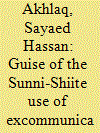

|
|
|
| 5 |
ID:
155361
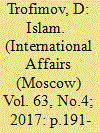

|
|
|
|
|
| Summary/Abstract |
THE WAVES OF DESTABILIZATION in the Middle East that have risen high in recent years, terrorist acts that follow one another, persecution of those who think differently or follow different religions in the Muslim countries and even outside them bring to mind, once more, Prof. Huntington. Indeed, can Islam and violence, Islam and democracy and, in the final analysis, Islamic and non-Islamic values cohabitate within the frames of the steadily globalizing community of men?
|
|
|
|
|
|
|
|
|
|
|
|
|
|
|
|
| 6 |
ID:
142530
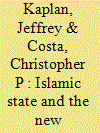

|
|
|
|
|
| Summary/Abstract |
This article focuses on the apocalyptic zeitgeist of the Islamic State through the lens of what we call the New Tribalism. It finds that IS emerged from the Al Qaeda (AQ) milieu, but soon split with AQ as the messianic excitement surrounding Al-Baghdadi and his teachings grew. In common with previous millennial/messianic movements in all three “Peoples of the Book”—Judaism, Christianity, and Islam—IS soon evolved beyond the laws of the normative faith (antinomianism). We hold that for this reason, despite its claims of faith and fealty, IS has left the Islamic Umah behind, becoming a malign sectarian group of its own whose dynamism and successes are attracting a global audience and support from Muslims in almost every country. This helps to explain such abhorrent practices as forced conversion, sexual servitude, the destruction of historic artifacts, and mass executions. We find that the American invasion of Iraq was the vital first step in a series of events, which gave birth to IS. A thorough review of IS history and political culture traces these historic moments in time.
|
|
|
|
|
|
|
|
|
|
|
|
|
|
|
|
| 7 |
ID:
122772
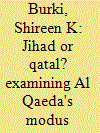

|
|
|
|
|
| Publication |
2013.
|
| Summary/Abstract |
There is widespread acknowledgment that the modus operandi of jihadis affiliated with Al Qaeda and associated movements (AQAM) relies on brutal terror-inducing tactics which, more often than not, target Muslim and non-Muslim non-combatants. This article comparatively analyzes the AQAM modus operandi within the traditional stipulations of Islamic precepts with respect to waging jihad al saghir. The purpose is to glean whether or not such tactics such as suicide bombings, declaring fellow Muslim apostates in order to kill them, use of IEDs and EFPs to target civilians, constitute legitimate rules of engagement in jihad al saghir.
|
|
|
|
|
|
|
|
|
|
|
|
|
|
|
|
|
|
|
|
|